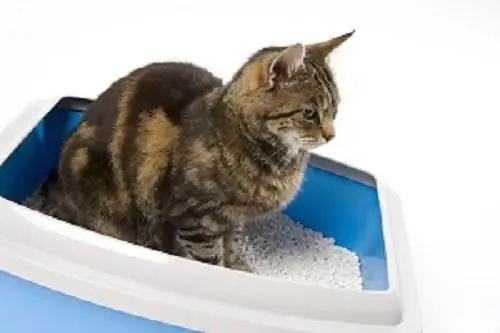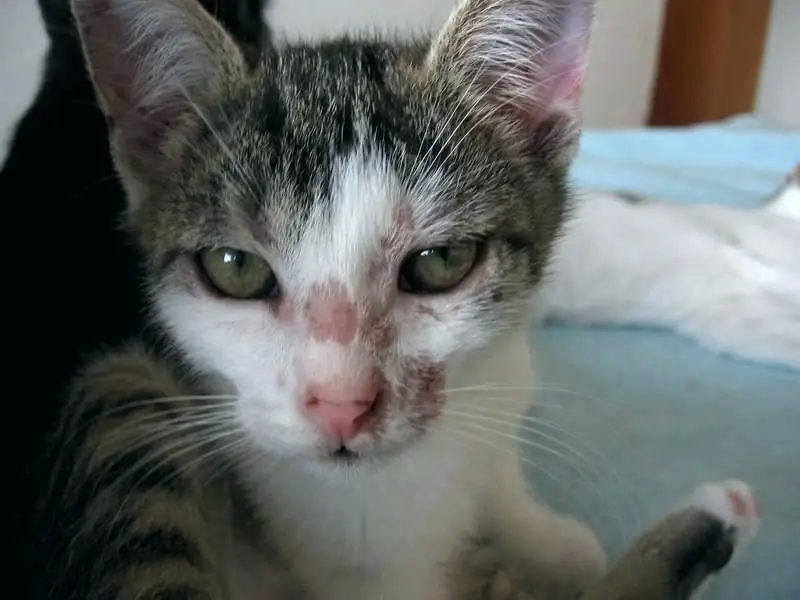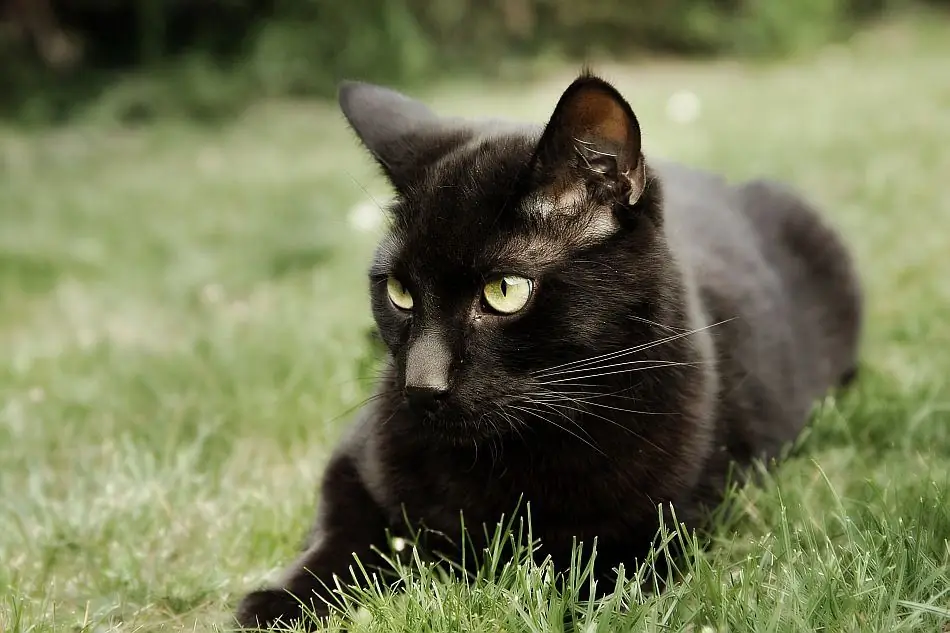2025 Author: Priscilla Miln | [email protected]. Last modified: 2025-01-22 17:55:27
The most common fungal skin infection in cats is lichen. It is diagnosed not only in stray animals, but also in pets. The fact is that its pathogens are very tenacious, and can get on the animal's fur from street shoes or the owner's hands. If earlier not every veterinarian knew how to treat lichen in a cat, now you can even deal with the problem at home. However, before doing this yourself, it is better to consult with a specialist and identify the type of disease. The fact is that there are types of fungi that can be transmitted to humans and cause serious illness.

Types of lichen
Most often, a cat is diagnosed with ringworm. The culprits of its appearance are fungi such as Microsporum, Trichophyton or Epidermophyton. In addition to it, a cat can be affected by pityriasis versicolor. It is caused by yeast-like fungi. Its peculiarity is that itspreads rapidly throughout the body of the animal, so immediate measures are required to treat it.
A pet can also get pink or red lichen. They are not as common, cause great discomfort to the cat, but tend to heal on their own with proper care. Veterinarians warn that fungal skin lesions require close attention from both the specialist and the owner.
Of course, it is possible to treat lichen in a cat at home, and quite effectively. However, it is best to consult a veterinarian and take the necessary tests to confirm the diagnosis.

Manifestations of microsporia
Fungal infestation is not difficult to detect for an attentive breeder at a very early stage. Initially, a small rash forms on the skin. However, with a thick coat of a pet, it is easy to ignore the first sign. But if you observe the animal for a while, then by its behavior it will be possible to guess about he alth problems. The cat becomes anxious and may refuse even the most favorite treat. In addition, the pet constantly combs the affected area.
As the disease progresses, the animal develops round bald patches, in the center of which the skin is covered with scales. The patch is itchy and uncomfortable. If nothing is done at this stage, the cat can scratch it to the point of blood, which will provoke a secondary infection. In addition, constant combing contributes to the spread of the fungus throughout the body andthe emergence of new foci of the disease.

Signs of pityriasis versicolor
This variety is almost invisible. There are no visible manifestations on the cat's skin. Already after the spread of the pathology, pale pink and yellowish spots are observed. They are most likely to be found on the neck, head or limbs.
Experts warn that the risk of disease increases with the presence of worms and malnutrition. There are also special breeds that are more prone to infection. So, Persian cats are completely devoid of immunity against fungi.
Diagnosis
Before treating lichen in a cat at home, it is necessary to show the animal to the veterinarian to establish the type of parasite that attacked the skin. To do this, the doctor conducts an external examination of the pet and a set of diagnostic procedures, among which the following are the most informative:
- examination of lesions under a fluorescent lamp;
- using a special Woods lamp, as other bacteria can be activated under the fluorescent glow;
- Scraping of infected skin and its microscopic and bacteriological examination.
Only after all the procedures, the specialist will make a diagnosis and recommend effective drugs that can be used at home.
Rules for leather treatment at home
Before treating ringworm in cats, some preparations should be made. In order for antiseptics to work effectively, they must be accuratelyapplication, and for this it is worth cutting the animal's hair. It is important to understand that it is a potential source of infection. Therefore, all sheared wool and the items used for this must be thrown away. Scissors are sterilized.
If crusts and scales have already formed on the skin, they are washed with warm soapy water. You can use a special antifungal shampoo.
Vets warn against a common mistake cat owners often make. Despite the great popularity, it is not recommended to use alcohol tincture of iodine for the treatment of wounds. Excessive use of them in a cat can cause a burn. In some cases, they even recorded anaphylactic shock.

Using antiseptics
All pet owners benefit from knowing how to treat cat lichen. Begin by treating the affected areas with antiseptics. This sequence is due to constant itching and the need to remove it as soon as possible. After all, microtraumas instantly appear from combing, which become inflamed and complicate the treatment process.
Vets recommend the following products:
- Salicylic alcohol. Refers to effective antibacterial agents that can fight colonies of various microspores.
- Fukortsin. A good antiseptic and antifungal agent. However, the phenol it contains can cause temporary lethargy in a cat. therefore, you should not abuse the remedy.
If the cat scratched harddamaged areas, then hydrogen peroxide, potassium permanganate or furacilin solution can be used for treatment.
Special ointments for lichen treatment
How to treat lichen in cats, the doctor will always tell you. To do this, you need to use special ointments to suppress the growth of bacteria. The most effective and commonly prescribed are the following:
- "Clotrimazole". A powerful active ingredient effectively fights all types of lichen in a cat and can be used at home. Of course, the full course is quite long - about a month. The ointment is applied three times a day. The drug has contraindications, it can not be used for pregnant and lactating cats. For a full-fledged course, the doctor may recommend the complex use of tablets, ointments or sprays.
- "Miconazole". A very effective antifungal agent. The affected skin is treated twice a day. The full course of cure can be up to two months.
- "Sanoderm". A complex remedy that has an anti-inflammatory and anti-allergic effect, and also relieves itching well. At the time of exacerbation, the ointment is applied to the affected area twice a day. After healing of wounds - once a day. The full course takes 4 weeks. If re-treatment is required, at least two weeks must have elapsed since the last use.
- Griseofulvin. An antifungal drug that is recommended for use in kittens. The cream is applied twice a day for two weeks. Veterinarians usually advise, in order to enhance the effect, its intake and in the formtablets by adding them to the food according to the instructions provided.
- YM. A complex drug that not only fights the disease, but also has an antiseptic effect. Processing is carried out twice a day for 7-10 days. It is important that a preliminary haircut is not required in this case. It promotes the appearance of new hairs in place of the affected areas. But the product is quite toxic, so it should not be used on kittens, pregnant and lactating cats.
Treatment term
How much to treat lichen in cats will depend on the severity of the lesion and the general condition of the animal. However, the full course, which is recommended for the use of ointments, must be completed. Even if the visible signs have disappeared, the cause of the disease still remains, which means that there is a risk of exacerbation, which will develop into a chronic form.
Using medicated shampoos
Before treating lichen in a cat at home, it is worth checking the type of fungus with a veterinarian. However, it would be useful to use special medicated shampoos.
Vets often prescribe Nizoral. It is based on ketoconazole, which has an antifungal effect. There is a more budgetary analogue, but no less effective - Sebozol. The use of these funds prevents the spread of infection throughout the body, has a therapeutic and preventive effect.
It is important to ask a specialist how to treat lichen in cats, what drugs to choose and calculate the dosage. After all, the instruction gives only an informational character, and in case of poor he alth of the animal, anyExceeding the norm of drugs can cause intoxication.
The use of folk remedies in the treatment of microsporia
If owners treat lichen in a cat with folk remedies, then the use of such measures is permissible only in the early stages. Their use is dangerous when the cat's condition worsens rather than improves. The following are considered the most effective and safe:
- Celandine juice. If the breeder identified the lesion at an early stage, then celandine juice has a good antiseptic and healing effect. It is necessary to lubricate problem areas 5 times a day.
- Lemon-olive ointment in a ratio of 1: 1. If there is no lemon juice, you can use apple cider vinegar. For treatment, a dressing impregnated with an emulsion is used, which must be fixed at the site of lichen formation. Bandages need to be changed every four hours.
- Ashes from the newspaper. Previously, in the absence of a wide variety of medicinal preparations, this method was very common. If it is not possible to use more effective means, then it is necessary to burn the newspaper and sprinkle the resulting ash every four hours on the infected focus.
- Wood ash. People in the villages know how to treat lichen in a cat. To do this, they collect wood ash, add oils and apply the resulting mixture daily to the affected areas of the skin. The tool is also common among summer residents, because it can be used as a fertilizer.

This is a fairly common problem. The article canfind photos of lichen in cats. How to treat the disease, it is better to ask a specialist. However, it is not always possible to get advice from a veterinarian. In this case, you can use folk remedies. But if after 2-3 days there is no visible improvement, it is necessary to resort to drug therapy.

Using sulfur ointment
The main localization of microsporia is the head. Often pet owners are interested in how to treat ringworm in a cat's ears. For this, it is most convenient to use sulfuric ointment. The drug is budgetary and affordable, but it is effective against fungal infections and inflammation. The essence of the pharmacological action is due to a powerful active substance, which gives impetus to the natural formation of pentathionic acid and sulfides in the body. They have antiparasitic wound healing properties.
Sulfur ointment consists of sulfur and petroleum jelly. The substances are absolutely harmless, so the product can be used to treat kittens, pregnant and lactating cats. No contraindications or side effects were recorded. Even if sulfuric ointment is applied to large areas of the skin in large quantities, intoxication is not observed. Therefore, the drug is used not only for animals, but also for people.

Varieties of sulfuric ointment and methods of treatment
On sale you can find several varieties of sulfur-containing ointments:
- Sulfur-zinc. Indicated in the diagnosis of the inflammatory process. Zinc dries wellcrusts and eliminates unbearable itching.
- Sulfur-tar. The drug contains the maximum amount of sulfur (10% of the total), so it fights fungi more effectively.
- Sulfur-salicylic. In this tool, sulfur is only 2%. But salicylic acid promotes increased blood circulation, which leads to a noticeable regeneration of the affected tissues.
It is necessary to understand how to treat lichen in cats using sulfuric ointment. In order to get rid of a fungal infection, it is necessary to apply the product on the affected area and along it up to two times a day until a complete cure.
Conclusion
Lichen can appear in any cat. In this case, it is important to notice the first signs in time and immediately begin treatment. Usually, the pathology is cured completely at home. But in order for the disease not to relapse, it is better to show the pet to the doctor.
Recommended:
How do cats treat people and what diseases?

Since time immemorial, cats have lived alongside humans. Today, it is representatives of this family that are most often given as pets. Communication with cats brings not only pleasure, but also he alth benefits. Scientific studies have proven that fluffy healers can help with many diseases. How do cats treat people, what breeds are known as the best doctors?
What are paraanal glands in cats? How to recognize and how to treat inflammation of the paraanal glands?

What is inflammation of the paraanal glands in cats, how to identify this disease, the causes of the disease, what treatment can be done - all this is described in the article
How to recognize and treat lichen in dogs

Causes of lichen in dogs, incubation period, symptoms of the disease, treatment, consequences, degree of contagiousness
Lichen in cats: how it manifests itself, causes, symptoms, types of lichen, treatment and advice from veterinarians

Deprive is called a fungal or viral disease that affects the skin. Such a pathology occurs in humans and, of course, in domestic animals. Very often we deprive suffer, for example, cats. To treat such a disease in a pet, of course, you need to immediately. Otherwise, the owners of the cat themselves can catch lichen. In addition, this unpleasant contagious disease often causes complications in animals
Where do cats go after death: do cats have a soul, do animals go to heaven, opinions of priests and owners of cats

Throughout a person's life, a very important question is of concern - is there life after death and where does our immortal soul end up after the end of earthly existence? And what is the soul? Is it given only to people, or do our beloved pets also have this gift? From the point of view of an atheist, the soul is the personality of a person, his consciousness, experience, emotions. For believers, this is a thin thread that connects earthly life and eternity. But is it inherent in animals?

